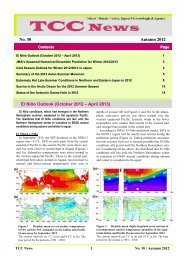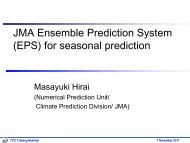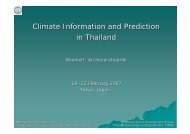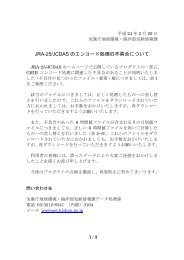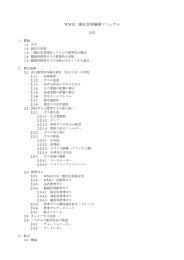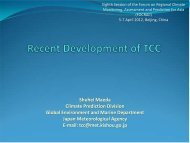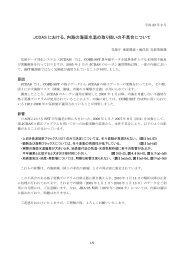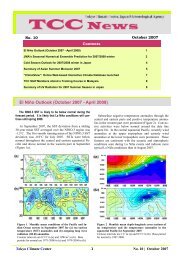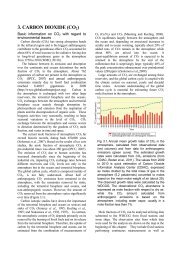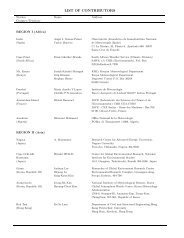TCC News No. 25
TCC News No. 25
TCC News No. 25
Create successful ePaper yourself
Turn your PDF publications into a flip-book with our unique Google optimized e-Paper software.
elements proliferate in a way that gradually encroaches upon<br />
vegetation. On dry, impermeable and lifeless urban surfaces<br />
with little vegetation left, the natural cooling thermostat<br />
based on evaporation and transpiration ceases to work.<br />
During the night, the high-rise buildings that pack city<br />
centers impede cooling caused by the emission of infrared<br />
radiation into space because of the reduced portion of open<br />
sky viewable from a given point on an urban surface. This<br />
increased urban canopy roughness reduces the passage of<br />
wind, leading to lower efficiency in the upward turbulent<br />
diffusion of near-surface heat. Additionally, anthropogenic<br />
heat emitted from air-conditioners, automobiles and other<br />
equipment that consumes energy cannot be underestimated<br />
in highly populated city centers. These factors are all<br />
known to contribute in varying degrees to the formation of<br />
UHI.<br />
Given that UHI is a climatological phenomenon whose<br />
effects are seen on a spatially limited scale of perhaps less<br />
than 100 km, it is obviously beyond the scope of the existing<br />
meteorological observation network to fully capture the effect’s<br />
spatial structure and evolution over time. The Japan<br />
Figure 2<br />
(a) Surface air temperatures over the Kanto Plain at 3 p.m. on 17 August 2010, as<br />
reproduced by a UCM simulation<br />
(b) UHI intensity defined as temperature differences between the urban simulation<br />
and the hypothetical non-urban simulation<br />
(c) UHI intensity in a northwest-southeast vertical section across the line segment<br />
connecting Point A through the center of Tokyo to Point B (shown in Map (b))<br />
The arrows represent wind velocity differences between the urban simulation and the<br />
non-urban simulation. The contours indicate potential temperatures.<br />
Meteorological Agency (JMA) operates a numerical urban<br />
climate model (UCM) that can resolve the atmosphere into<br />
4-km horizontal grids to allow investigation of how UHI<br />
evolves in Japan’s metropolitan regions and measurement of<br />
the extent to which the phenomenon accounts for higher<br />
urban temperatures. Climate model simulation makes it<br />
possible to reproduce temperatures under actual urban<br />
ground conditions as well as to estimate how the climate<br />
might be under hypothetical ground conditions with no influence<br />
from urbanization. Comparing the results of hypothetical<br />
non-urban simulations with those of realistic urban<br />
simulations produces a clear picture of UHI’s characteristics.<br />
On 17 August, 2010, the temperature soared to 37.2°C<br />
according to the thermometer at the station of JMA’s headquarters<br />
in Tokyo. This was the highest temperature of the<br />
summer, which in turn proved to be the hottest season in<br />
more than a century of climate records. The results of<br />
UCM simulations for that day are shown in Figure 2. The<br />
urban simulation with actual ground boundary conditions<br />
reproduces high surface air temperatures exceeding 35°C<br />
from the coast of Tokyo Bay toward<br />
the inland area of the Kanto<br />
Plain (Figure 2 (a)). The<br />
non-urban simulation with ground<br />
boundary conditions replaced by<br />
hypothetical pristine grassland<br />
provides reference temperatures<br />
for comparison (not shown).<br />
Subtracting the non-urban temperatures<br />
from the urban temperatures<br />
on a grid-by-grid basis produces<br />
a snapshot of UHI intensity<br />
(Figure 2 (b)).<br />
It is notable that the peak UHI<br />
intensity, which is larger than<br />
+3°C, does not appear in the most<br />
densely populated area along the<br />
coast of Tokyo Bay, but instead<br />
tends to sprawl further inland.<br />
The landward shift of the peak<br />
UHI appearance indicates that the<br />
relatively cool sea breeze from<br />
Tokyo Bay is hampered from<br />
reaching inland areas by increased<br />
surface roughness and a<br />
well-developed vertical mixed<br />
layer over central Tokyo (Figure 2<br />
(c)).<br />
(Yoshinori Oikawa,<br />
Climate Prediction Division)<br />
<strong>TCC</strong> <strong>News</strong> 2 <strong>No</strong>. <strong>25</strong> | Summer 2011



